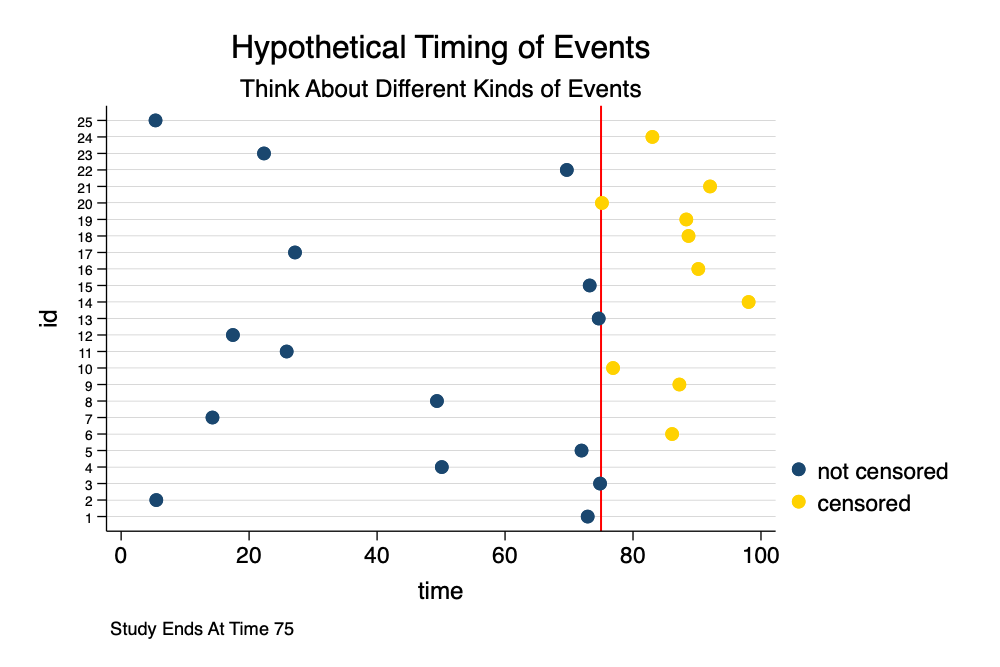Introduction
“Survival analysis is a key technique in data-driven decision-making, which is now central to public interest because of COVID-19. Applying the correct technique for the specific question at hand is crucial for credible public health inferences. If you are interested in assessing how a risk factor or a potential treatment affects the progression of a disease—such as how long a patient takes to recover—then survival analysis techniques come into play. Survival analysis deeply respects the ultimate source of its data, often the disease experience or even the life and death of human patients. It seeks to exploit every last drop of information that this experience can render for saving lives—in particular, not only whether patients survived, but how long, and why. And it strives to do so with minimal assumptions, so that the data are truly driving the decision.”
—SAS Corporation
The “Hospital Bed Problem”
Imagine a Hypothetical Hospital
Imagine that there are 52 patients total.
51 of the patients are long term patients, who each stay for 1 year.
1 of the patients is a short term patient, who stays for 1 week.
Is this a hospital that serves mostly long-term, or short term patients?
. set obs 52 // 52 hypothetical obervations
Number of observations (_N) was 0, now 52.
. generate id = _n // set id = to observation #
. replace weeks = 1 if id == 52
(1 real change made)
. twoway (scatter id weeks if weeks == 52, msize(small)) /// staying 52 weeks
> (scatter id weeks if weeks == 1, msize(small)), /// staying 1 week
> title("Hypothetical Hospital") ///
> legend(on order(1 "long term" 2 "short term")) ///
> xtitle("week of discharge") ///
> ylabel(1(1)52, labels labsize(tiny) angle(horizontal) noticks nogrid) ///
> scheme(michigan)
. graph export hospital_bed_problem.png, width(1000) replace
file
/Users/agrogan/Desktop/newstuff/categorical/survival-analysis-and-event-history/hospital_bed_p
> roblem.png saved as PNG format
How To Measure Length of Stay (1)
. set obs 25 // 25 hypothetical obervations
Number of observations (_N) was 0, now 25.
. generate id = _n // set id = to observation #
. generate time = runiform(1, 100) // random times
. generate censored = time > 75 // censored if time > 75
. twoway (scatter id time if censored == 0) ///
> (scatter id time if censored == 1), ///
> title("Hypothetical Timing of Events") ///
> subtitle("Think About Different Kinds of Events") ///
> note("Study Ends At Time 75") ///
> legend(on order(1 "not censored" 2 "censored")) ///
> xline(75, lcolor("red")) /// censoring line at 75
> ylabel(1(1)25, labsize(vsmall) angle(horizontal)) /// lines from 1 to 25
> scheme(michigan)
. graph export timing_of_events.png, width(1000) replace
file
/Users/agrogan/Desktop/newstuff/categorical/survival-analysis-and-event-history/timing_of_even
> ts.png saved as PNG format
Hazard (Risk) of Event Occurence
A more heuristic definition:
\[ h(t) = \lim_{\delta\to 0} \frac{\text{probability of having an event before time } t + \delta}{\delta} \]
This definition per Johnson & Shih (2007)
\[ h(t) = \lim_{\Delta t \to 0} \frac{P(t \le T < t + \Delta t | T > t)}{\Delta t} \]
This definition per Ragnar Frisch Centre for Economic Research (2020)
References
Johnson, L. L., & Shih, J. H. (2007). CHAPTER 20 - An Introduction to Survival Analysis (J. I. Gallin & F. P. Ognibene, eds.). https://doi.org/https://doi.org/10.1016/B978-012369440-9/50024-4
Ragnar Frisch Centre for Economic Research (2020). Event History Analysis, Survival Analysis, Duration Analysis ,Transition Data Analysis, Hazard Rate Analysis. Oslo, Norway.





